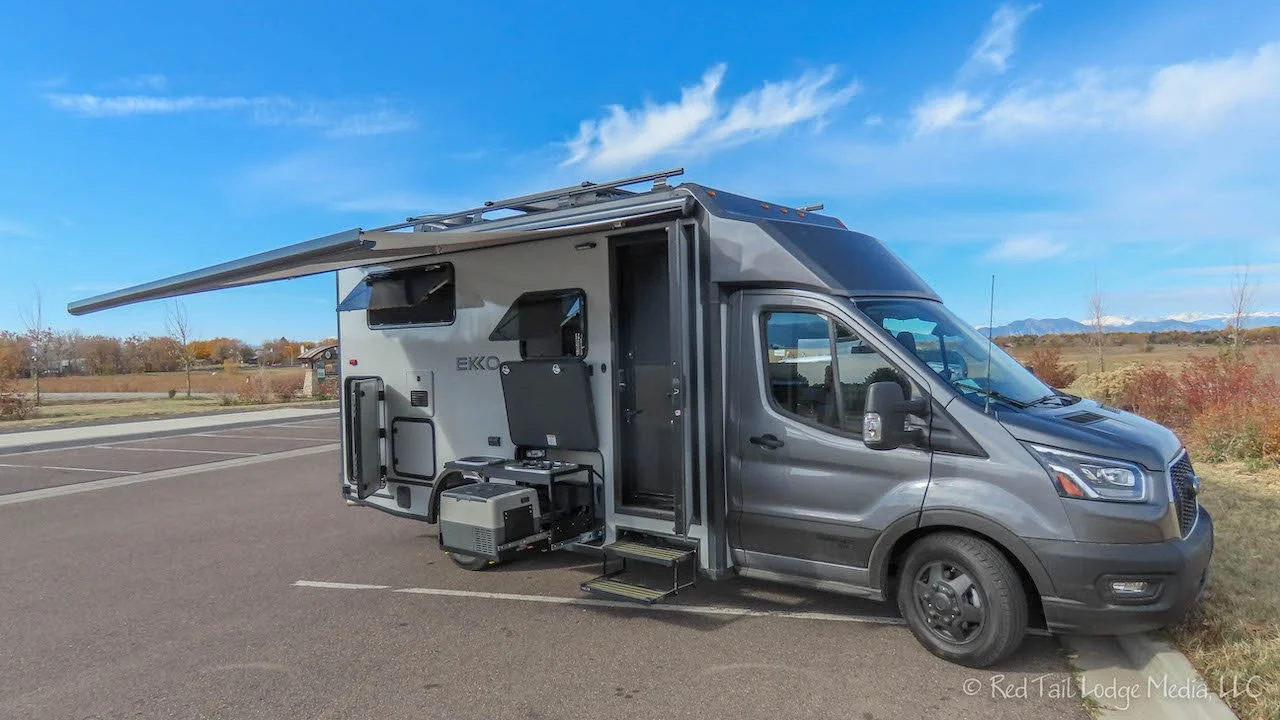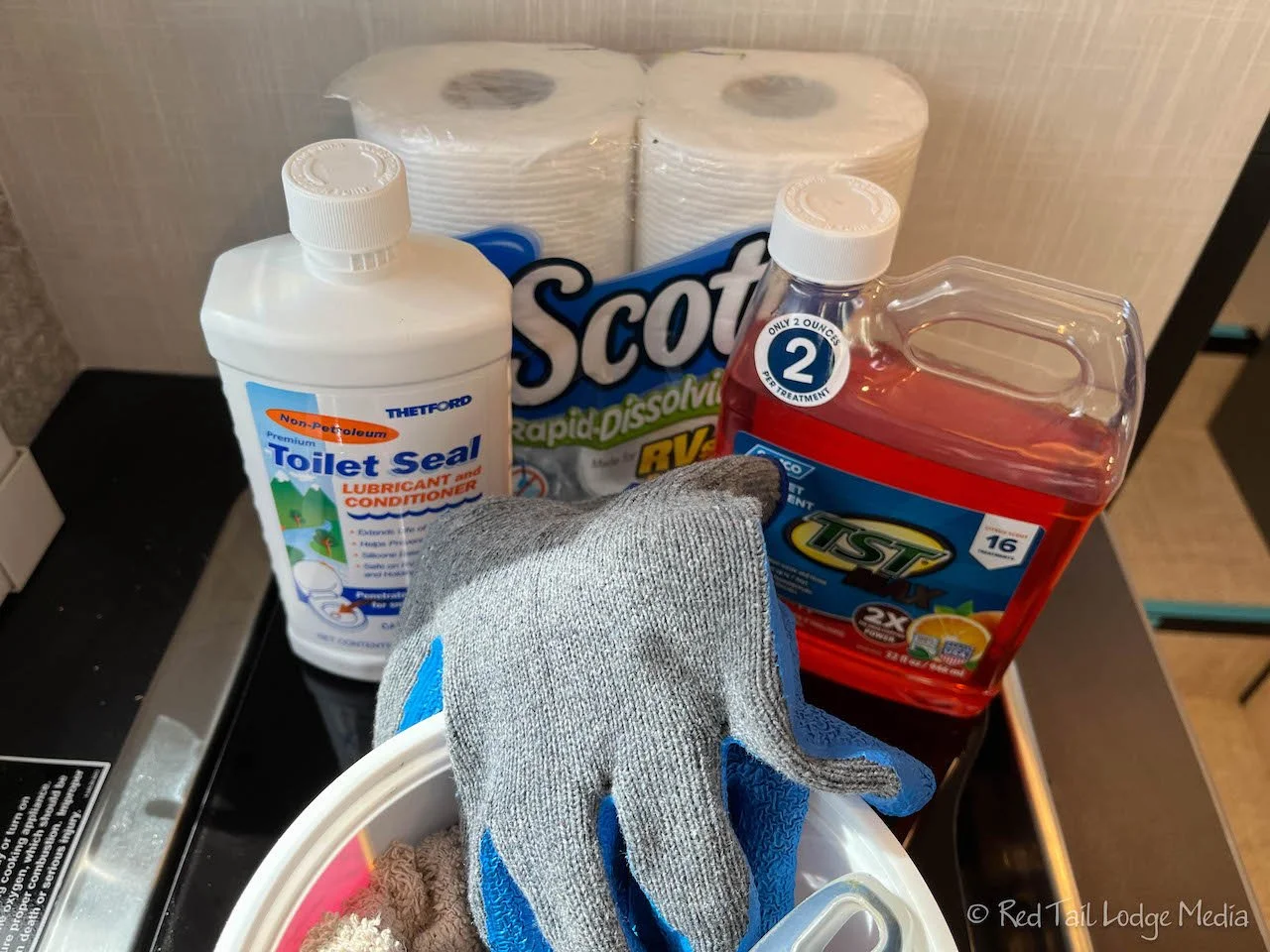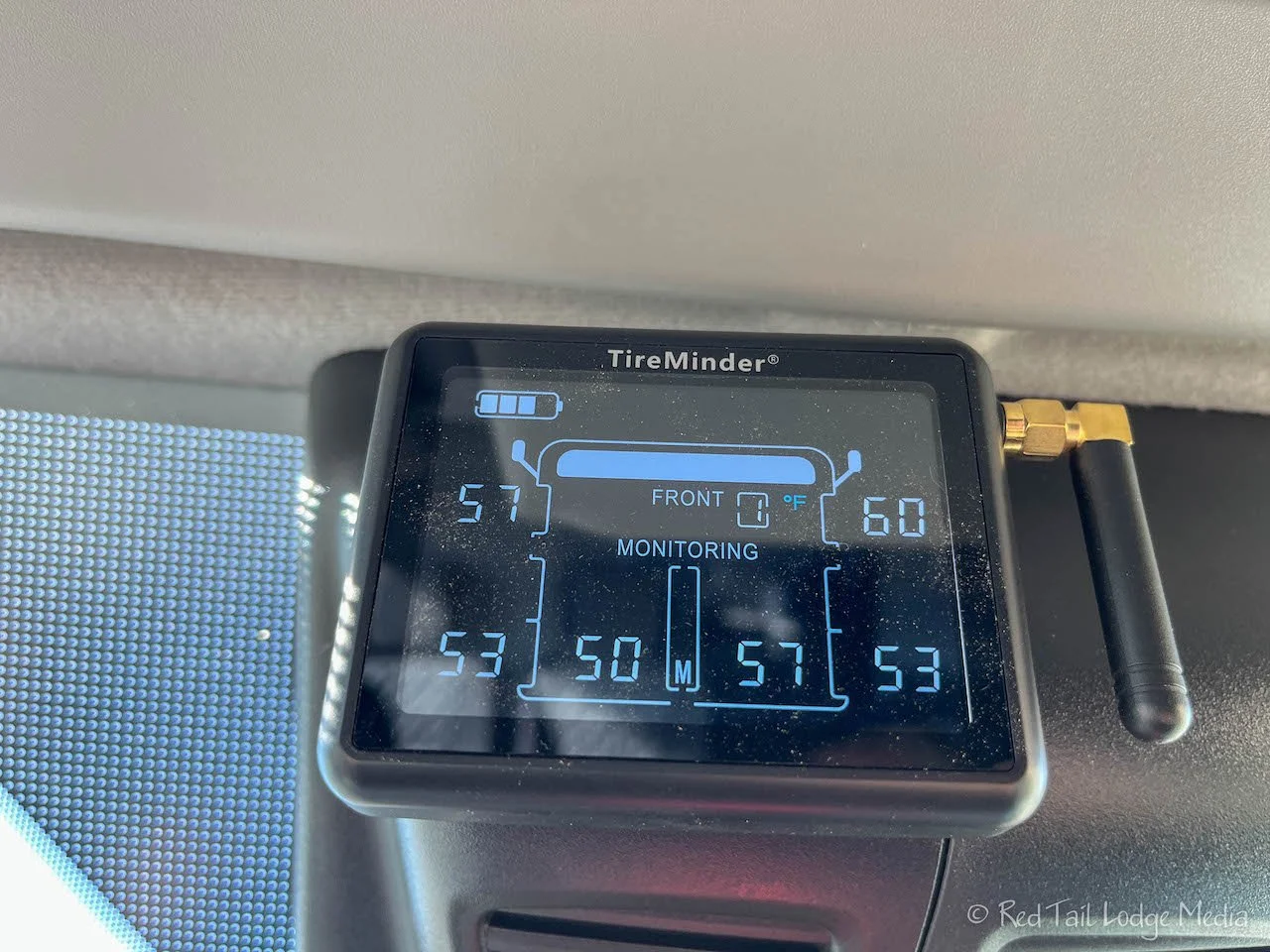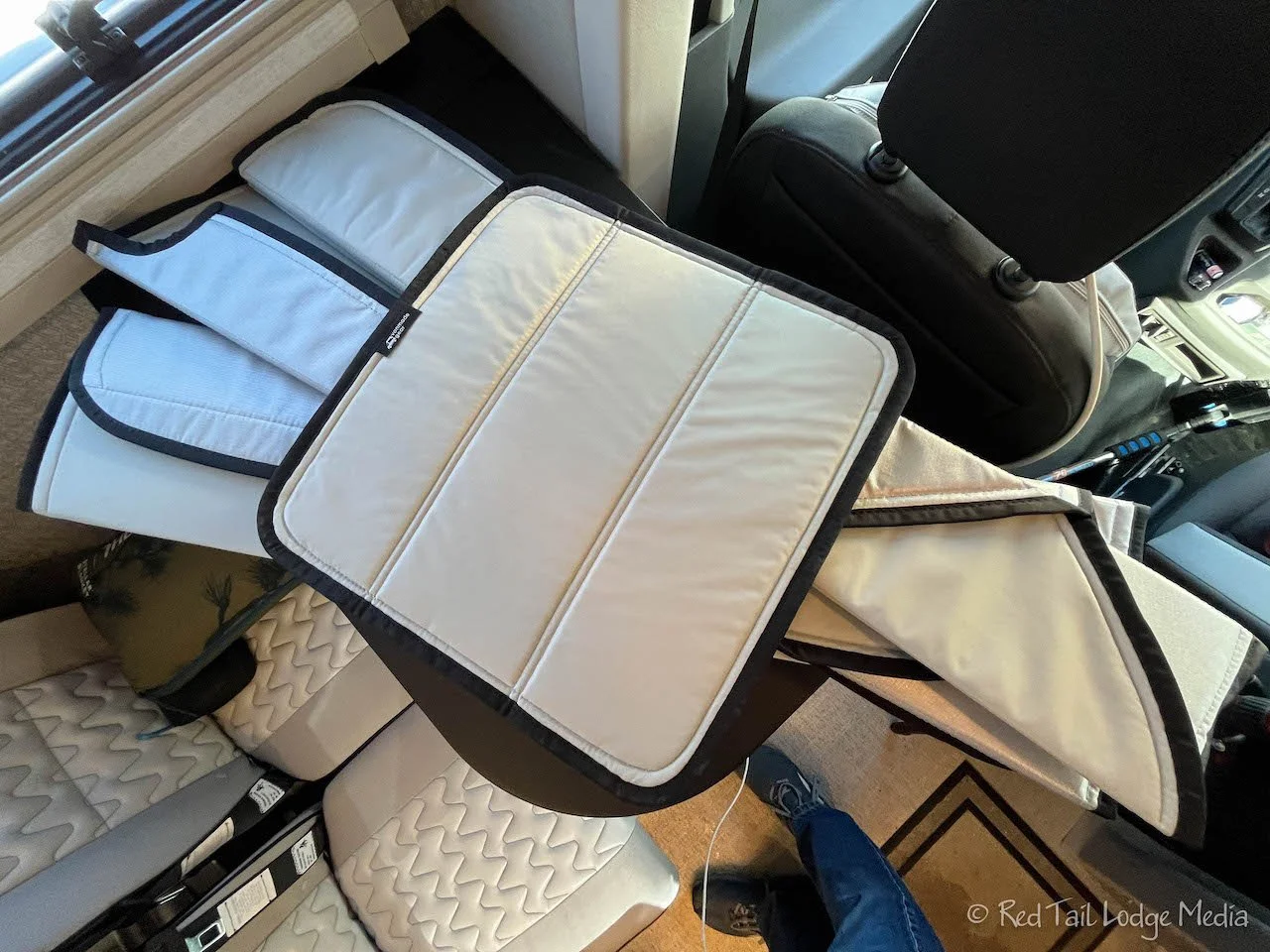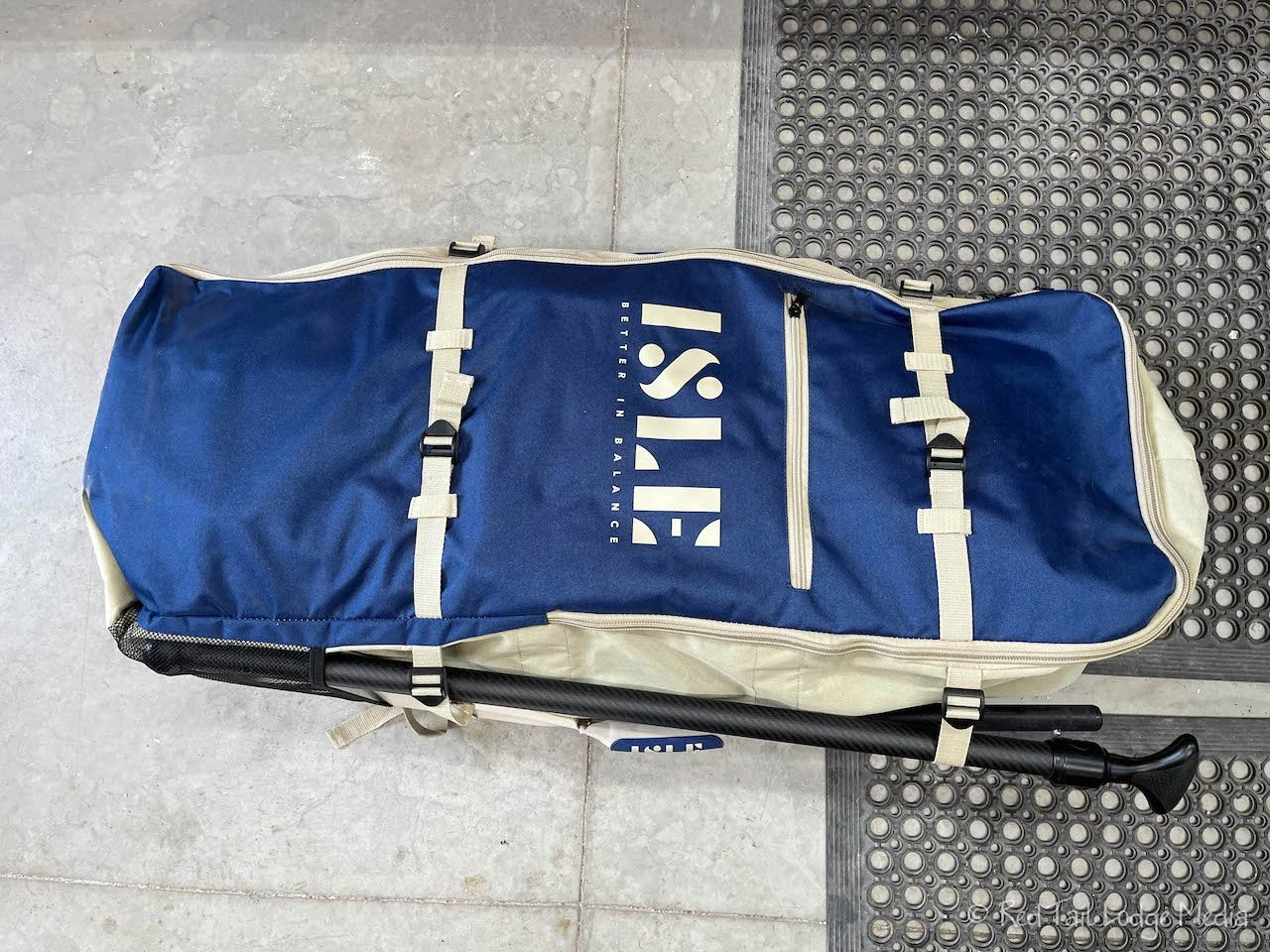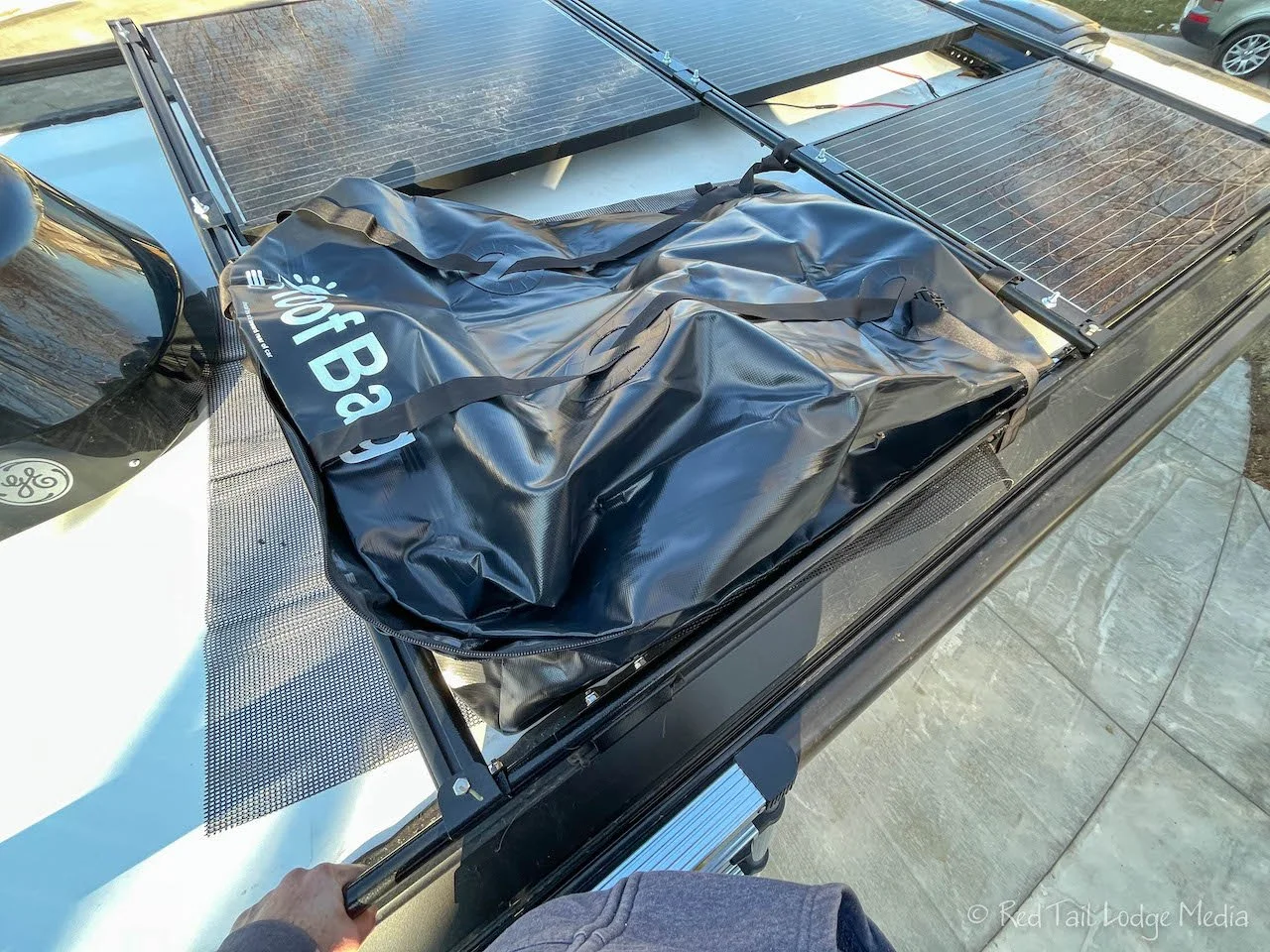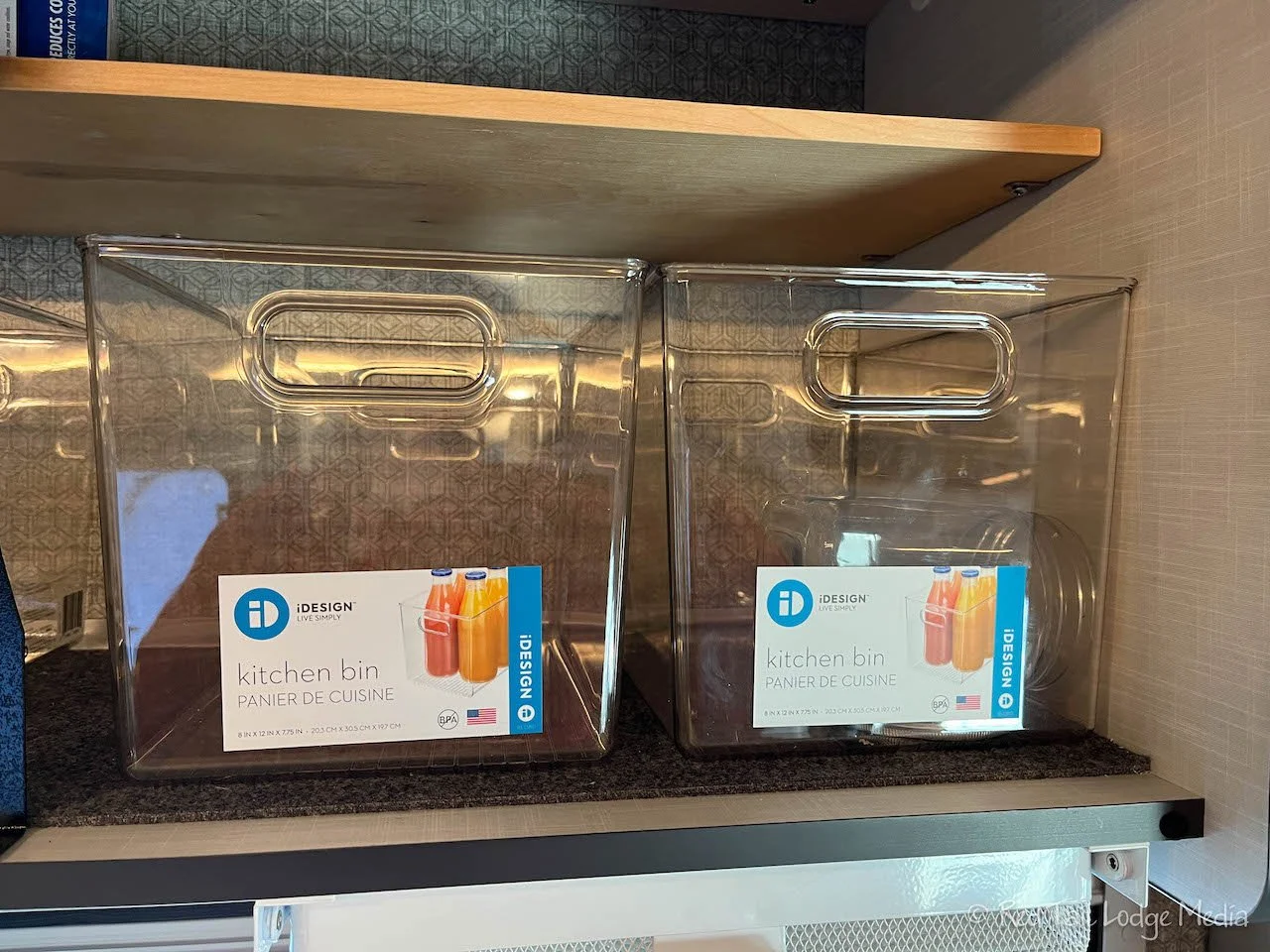New Gear for Season Five 2023
We are really mixing things up for Season Five. We have changed out a lot of our gear and will be trying out new things. This is probably the longest list of new gear for a season since we started four years ago. Here are the items in no particular order.
Item One: Winnebago EKKO
The biggest change for Season Five is switching rigs. We sold our VanDOit camper van and bought a Winnebago EKKO. See our previous posts for more details: Red Tail Lodge Two and Red Tail Lodge (VanDOit) Vs. Red Tail Lodge Two (EKKO).
Item Two: Toilet Supplies
Now that we have a real toilet, we needed to get some supplies that we didn’t have in our camper van. These supplies include RV toilet paper, toilet chemicals, rubber gloves, the Americanizer (paid link), and toilet seal lubricant (paid link). RV toilet paper is designed to break down easier than normal toilet paper. Toilet chemicals help things break down and reduce the odors. Rubber gloves are used to dump the toilet cassette and the gray water tank to keep your hands clean. The Americanizer, designed and sold by James at the FitRV, makes it easier to dump the toilet cassette into an RV dump station. Toilet seal lubricant protects the seal and helps prevent waste from sticking.
Item Three: Fresh water supplies
In our camper van, we used 6 gallon jerry cans for our fresh water. Because we could move the jerry can to a fresh water fill, we could use a really short water hose. The EKKO has a large fresh water tank. We may not be able to position the fresh water fill as close to the water fill as we could a jerry can, so we need to carry a longer water hose. We made sure the hose (paid link) was rated for drinking water. Since we drink the water from our fresh water tank, we need to keep the water hose clean, so we purchased caps (paid link) to prevent dirt and bugs from entering the hose while it is stored. The tank is filled through a gravity fill inlet. We purchased an RV water tank filler (paid link) which will hopefully make that process easier and a little less messy. We have not used it yet, so we’ll let you know if it was worthwhile or not. In order to be able to blow out the water lines using an air compressor when winterizing, a blow out valve (paid link) is needed. We picked one up at an Ace Hardware store.
Item Four: Hughes Watchdog surge protector
Our camper van used 20 amp shore power and we could not find an RV surge protector for 20 amps, so we lived without one. However, we like the peace of mind that comes with protecting the RV’s electrical system from potential issues with a campground’s electrical hook up. The EKKO uses a 30 amp connection, so we purchased a Hughes Watchdog surge protector (paid link). If your RV has a 50 amp connection, Hughes Watchdog also comes in a 50 amp version.
Item Five: GoTreads leveling blocks
We have used leveling blocks in the past with our camper van. First we tried Camco leveling blocks, but after a season or two of use, they cracked and fell apart. We replaced them with Beech Lane Camper Levelers (paid link) which seemed to hold up better and were easier to use. However, the van only had four tires and the EKKO has six, so we needed to purchase more leveling blocks. We decided to try something different and purchased GoTreads (unpaid link). Not only can we use them as levelers, but we can also use them as traction mats if we ever get stuck in snow, mud, or sand. We’ll report back after we’ve used them for a while.
Item Six: Tire Pressure Monitoring System (TPMS)
We loved having a TPMS in our camper van, so we installed one in our EKKO. More details about the TPMS (paid link) are in the Our EKKO Modifications post.
Item Seven: New bedding
We had a queen sized bed in our camper van, but the EKKO has two twin beds, so we needed to purchase different bedding. Before we picked up our EKKO, we bought two sets of twin sized bedding which included pillow cases, shams, top and bottom sheets, and a comforter. However, the EKKO beds are not a standard twin size, so the sheets fit too loosely and got in the way of opening the drawers under the beds. So we ordered cot-sized sheets which fit much better. The EKKO mattresses are each 32” x 76” while a typical twin mattress is 38” x 75”. Cot sheets come in varying sizes. We purchased cot sheets that measure 32” x 75” and they fit pretty nicely on the EKKO mattresses. We kept the comforter and shams from our initial twin bed purchase.
Item Eight: Water Heater Supplies
The water heater in our camper van was small, electric, and simple. Winterization of our van was much faster and easier than winterizing the EKKO. However, for the EKKO, we purchased some items to help us with our Truma Water Heater, which is propane powered. First was some water heater decalcification tablets (paid link) for keeping the water heater in good condition. We also purchased the Truma AquaGo Electric Antifreeze Kit so that we don’t have to worry about the water heater freezing when traveling in the shoulder seasons. We plan to only use it when it looks like the temperatures will drop below freezing on travel days.
Item Nine: Tire Supplies
We have never owned a vehicle with dually tires before, so there were some items we needed to deal with them. First was a Viair air compressor with a long filler stick to reach the inside tires (VIAIR 450P- 45053 RV paid link). Next was a tire pressure gauge (paid link) with a long stem for the same reason. We also got a tire depth gauge (paid link), which isn’t something different for dual tires, but we didn’t have one. A tire depth gauge will allow us to check our tires more often for wear. We were caught off guard a little in Anchorage last year when it was discovered that our tires were wearing faster than we realized. Luckily it was caught while we were having some maintenance done, but we had trouble finding the right sized tires in Anchorage (Anchorage, Alaska - June 28th to July 4th, 2022).
Item Ten: Cab window shades and ceiling fan cover
We were not impressed with the front cab curtain that comes with the EKKO (different from the insulated one that snaps into place behind the front seats - we like that one). The curtain Velcros into place around the cab windows. But it sags, so it is not very good for privacy. And it is not very insulating, so it is not good from keeping out the heat or cold. The insulated curtain is good for keeping the rest of the coach warm or cool, but does nothing for the cab. So we purchased cab window shades from Van Made Gear (unpaid link). While we were at it, we also ordered the insulated ceiling fan cover. We’ll keep the fan covered when it is not in use. You can never have too much insulation in an RV. When we had our windshield replaced (yes, we already cracked our windshield), we had Safelite (unpaid link) remove the rear view mirror. The mirror is useless since there is no window out the back of the EKKO. The mirror was a distraction because moving reflections would catch the driver’s eye and attention. The mirror also makes it harder to take the shade in and out of the windshield. Good riddance.
Item Eleven: E-bikes
We sold our Trek hybrid bikes and bought Rad e-bikes. We plan on using the e-bikes without the assist turned on, and only use the assist when we need it. Our hope is that e-bikes will extend our range, not only with bike rides, but also for running errands, so we don’t have to pack up our RV as often. Part of the reason for buying the EKKO was to give us room to store the e-bikes inside, instead of using an external bike rack. This allows us to keep the e-bikes out of the weather and provides a little more security. We both bought the Rad Expand 5 (unpaid link). For our height, the bike is really too small for us, but we wanted them to fit in the gear garage. Keith rides his with the seat up as high as it will go. Ann’s legs are longer. She has a 37 inch inseam, so she searched for a longer seat post. We struggled to find a longer one that was available. We ended up getting an expensive one (paid link) that includes some suspension. If it saves Ann’s knees, the price will be worth it. The seat post is still about an inch too short, but Ann figures that she can always turn on the power assist when her knees start to hurt. We found a little Rad popup store in Denver where we could test ride the bikes before buying them. They also had the bikes on hand so we were able to purchase them on the spot. However, the bikes come disassembled, so we had to spend a little time assembling them after we got home. We went all out and purchased a bunch of accessories. They include locks, water bottle holders, cell phone holders, panniers, seat bags, quick release pedals (paid link), and a bike pump. The quick release pedals give us more space in the gear garage when we store the bikes. The bike pump was needed because the e-bikes have much larger tires than our previous bikes. The pump we purchased (paid link) is for high volume. We haven’t ridden the bikes much since it was winter, so we’ll report back later on how well we like them. For more details on how we secured the e-bikes in the gear garage, check out our previous post: Our EKKO Modifications.
Item Twelve: SUP board
This is another change. We sold our inflatable kayak and bought a Stand Up Paddle (SUP) board. Ann loves the water, but Keith is not a fan. Ann was hoping Keith would become more comfortable kayaking with more experience, but that didn’t happen. Half the time she was taking the kayak out by herself. Maneuvering a two-person kayak by herself was not fun. Besides, the e-bikes take up most of the gear garage and there is no room for the kayak. The SUP board (paid link) takes up less space, so Ann decided to give it a try. She’s never used a SUP board before, so this may be interesting. We’re going to be around water and in warmer temperatures during Season Five, so Ann is hoping she’ll use the SUP board quite a bit.
Item Thirteen: Soft-sided roof bag
Well, with the e-bikes in the gear garage, there isn’t room left for the SUP board, so our only other option was to put it on the roof of the EKKO. We found a soft-sided roof bag (paid link) that fits perfectly in the available roof space. Most of the roof is taken up by solar panels and the air conditioner, but there is one square space left between the roof rack rails. The roof bag not only holds the SUP board, but there is room left over for our backpacking gear. We haven’t been backpacking since Season One (Day One Below Rim: Grand Canyon - Sep 16, 2019). For Season Five, we have a short backpacking trip planned, just two nights out on the trail.
Item Fourteen: Blackstone griddle
We traded in our single burner butane camp stove for a Blackstone Griddle (paid link). Since the EKKO has an external propane connection, we didn’t want to haul around butane in addition to the propane already needed in the EKKO for the indoor stove, water heater, and furnace. Plus the Blackstone Griddle is a much larger cooking surface. That means we don’t have to cook those tortilla pizzas one at a time. The accessories that we purchased along with the griddle are a quick connect adapter (unpaid link), a metal spatula set (paid link), and a spare grease catcher along with grease cup liners. The spatula set comes with two squirt bottles. We plan to use one for oil and one for water. The oil is for cooking and seasoning the griddle while the water is for cleaning the griddle afterwards. The spare grease catcher was a nice way to store the squirt bottles upright in the storage compartment and prevent them from falling over. The Blackstone Griddle is a carbon steel cooking surface, so it must be seasoned before using. We set up the griddle in our driveway and seasoned the griddle with it attached to our EKKO’s propane. This also tested the propane connection at the same time.
Item Fifteen: Induction Cooktop
Another new cooking addition was an induction cooktop (paid link). We’ve never cooked using induction, so we thought we would test it out. The EKKO has a two burner propane cook top, so the induction cook top is not really needed. However, it might come in handy when our propane is running low. And who knows? Maybe we’ll like it so much that we’ll remove the propane cooktop like James did at the FitRV. However, the induction cooktop is just a single burner, so we’re not planning on removing the propane cook top. The induction cook top can also be used outside, so we could imagine that there may be times that it is easier to pull out the induction cook top instead of setting up the Blackstone griddle outside.
Item Sixteen: New Cookware
The stacking camping pots that we were using in our camping van were old, probably approaching thirty years old. They were non-stick and scratched. So who knows how many carcinogens we were consuming. It was time for a new set of pots and pans. We also needed pans that would work with an induction cook top. We went with the Magma 10 piece nesting cookware (paid link), the induction compatible version. The nesting aspect is essential for a camper van or RV, as the cookware takes up less space.
Item Seventeen: Hand dust buster
In the camper van, we used a small hand broom and dust pan to sweep out the floor of the living space. However, the living space in the EKKO is much larger. Plus, it is hard to get the dirt out of the corners and little crevices with just a broom, so we added a little dust buster (paid link) to our repertoire.
Item Eighteen: Taller coffee mugs
The small microwave in our camper van was pretty short, so we had a couple of microwaveable coffee mugs, with lids, that were short enough to fit. However, the microwave in the EKKO is taller, so we purchased the same type of mugs we had before, but in a taller version (paid link). More coffee is better, right?
Item Nineteen: Smaller exercise mat
Ann is six feet tall, with long legs, even for her height. She has a stretching routine she likes to do every evening. We had been traveling with a rather large exercise mat so Ann could stretch at the campground without sitting in the dirt. However, we could not find room to store that large mat in the EKKO, so we downsized from a 7’ x 4’ mat to a 6’ x 3’ one (paid link).
Item Twenty: New day packs
We normally travel with two different sizes of day packs. One size is a 24 liter that we normally hike with, which has padded hip belts. The other one was 18 liters, a Flashpack from REI. Despite not a big difference in capacity, the REI Flashpacks (unpaid link) are lighter. The hip belts are not padded and the pack does not have an internal frame like our other backpacks. We use the smaller ones when we are going on a short hike or walking around town and we don’t need to carry heavy gear or a lot of water. However, the Flashpacks that we had did not have an external pocket for a water bottle, which meant the water bottle went inside the pack. This turned out to be a pain. It meant that you had to take the pack off your back every time you wanted a drink. We replaced those Flashpacks with a newer version of the Flashback that has external pockets for water bottles. It is larger, 22 liters instead of 18 liters, and about the same weight as before, just more convenient. We’ll also be traveling with a third size of backpack this season, for backpacking. These packs are not new, but ones we have used before. Ann’s backpacking pack is 55 liters. Keith will be taking his 50 liter backpack. More space is needed for backpacking since we need to carry a tent, sleeping bags, food for three days, a backpacking stove, a cooking pot, and a change of clothing.
Item Twenty One: 12 V power drill
Keith added a 12 V power drill (paid link) to his tool bag this season. We’ll cover all the tools we travel with in a future blog post.
Item Twenty Two: New laundry hamper & laundry backpack
The laundry hamper that we had been using for the past four seasons was falling apart. It also was not the easiest thing to lug across the campground to the laundry room. We found a laundry hamper (Simply Essential Parker Hamper - unpaid link) that fit perfectly in the wardrobe closet under the bed on the passenger side. It is a hard-sided hamper with a cloth liner. In addition, we purchased a llaundry backpack (unpaid link) to make it easier to carry our dirty clothes to the laundry room. The plan is to pull the liner out of the hamper and plop it into the backpack when we’re ready to do laundry. We’ll let you know how it works out.
Item Twenty Three: Space-saving kitchen utensils
Although the EKKO is larger than our camper van, it feels like we gave up storage space. Of course, we gained lots of living space. In order to make things fit better in the storage space we have, we traded some of our kitchen utensils for more space-saving versions. These included switching from a regular whisk to a flat whisk (paid link), from a box grater to a collapsible one (paid link), and from a regular colander to a collapsible one (paid link). Now everything fits!
Item Twenty Four: Variety of storage bins
Storage bins are a great way to maximize the space you have and make it easier to find and access items. Between the beds, we added two soft storage boxes with lids (paid link) which gives us more storage while still allowing us to set things on top of the boxes like our phones, a laptop, or iPad. In the overhead cabinets in the bedroom, Ann added a couple of soft bins (unpaid link) to organize her clothes. She found that reaching over the bed to pull out the one shirt she wanted from the stack was awkward without the bins. With the bins, she can easily pull down a bin, grab what she wants and put the bin back. Keith chose not to use bins on his side. In the driver side wardrobe closet under the bed, we put a clear plastic bin (unpaid link) under the shelf we installed and put a soft-sided bin (paid link) on top of the shelf. The clear bin is for storing shoes to help contain the dirt and sand. The soft bin is for more clothing. In the dinette cabinet, we added three clear bins (unpaid link) to hold pantry items. The clear bins make it easy to find what we want. We can easily pull down a bin and reach an item in the back of the bin while still keeping everything organized. Without the bins, we would be shuffling items around to find what we wanted. The bins also allow us to take advantage of the vertical space by stacking items inside the bins, while minimizing how many items we need to move around to access what we need. The bins also help prevent things from sliding around too much while driving down the road. The top drawer under the sink is rather narrow, but has some height to it. We are storing mainly kitchen utensils and silverware in there. To keep things organized while being able to utilize the height, we bought a narrow bin (unpaid link) that fits well in the space. There is a small amount of space left over to store our knives alongside the bin, with the blades facing up, protecting their edges. We have them in knife sheaths so it is not a safety issue. To keep the silverware separate from the other utensils, we bought a small zippered bag that holds all of our silverware. The bag makes it easy for hauling the silverware outside to a picnic table.
Item Twenty Five: CGear sand free mat
We’ve heard good things about the CGear sand free mat (unpaid link). However, we debated about getting it because we like to minimize our time for setting up camp and break camp. We like to be nimble and move often. In the past, we typically only stayed at a camp sites for two or three nights. For Season Five, our stays will be longer, from three to five nights at most sites. So we’ll see how often we get the mat out. We like the idea of having an area right outside our rig where we can lounge without worrying about getting our feet dirty, muddy, or sandy. Time will tell if the comfort is worth the effort of getting the mat out and putting it away.
Item Twenty Six: Fire extinguisher
The EKKO comes with a fire extinguisher, but we recently discovered a new type of fire extinguisher, the Element Fire Extinguisher (paid link). It is small and never expires. It is not toxic, the discharge is safe to breathe, and it does not leave a residue when used. It works for all kinds of fires. We bought one for our kitchen at home and another one to take with us in our EKKO. For more information, check out their website (unpaid link). There are some impressive videos on their media page (unpaid link). We still have the original fire extinguisher in the EKKO, but we may remove it at some point.
Item Twenty Seven: Moon Shade Accessories
Depending on the orientation of your camp site and the time of day, the RV awning is not always in a good location. In the past, we have traveled with a Moon Shade (unpaid link) in addition to the awning on our camper van. Our Moon Shade came with strong magnets to attach it to the side of our van. In addition, we attached eyebolts to the roof rack of our van on the opposite side from our awning. The Moon Shade easily attaches to those eyebolts. Since we do not have the Batwing awning on our EKKO, we are taking our Moon Shade with us for Season Five. However, the EKKO is not metal and the Moon Shade magnets will not work. We did not add eyebolts to our EKKO roof rack because the EKKO is taller and it seems like the shade would be too high to give us good shade most of the time. Therefore, we bought the Moon Shade suction cups so we could attache it too the side of our EKKO. In addition, we also purchased the screw ground anchors to better secure the Moon Shade against the wind. We’ve found that the Moon Shade performed better in the wind than our camper van awning. We’ll see how the Moon Shade suction cups compare to the EKKO awning in the wind.
Item Twenty Eight: Camera floats
For Season Four, Ann had a floaty handle (paid link) for the GoPro camera along with floating, waterproof bags (paid link) for our iPhones. Both worked pretty well in wet environments. However, Ann was not sure how much she liked the floaty handle. The wrist strap did not stay tight to her wrist. The floaty handle also does not have a tripod option like the Shorty handle (paid link) does that she uses in dry situations with the GoPro. Now that we have a SUP board, Ann envisions that she would like to prop the GoPro up on the front of the board. She could use the Shorty handle as a tripod along with bungee cords to secure it. However, she is concerned that it might come loose and doesn’t want to watch the GoPro sink to the bottom, out of sight and out of reach. So she bought a couple of camera floats (paid link). Each float is strong enough to keep the GoPro floating, but not with the additional weight of the Shorty stick, so two floats are required. The floats could also be used to keep her Canon Powershot (paid link) afloat in the event that she dropped it overboard on a boat ride. The Powershot is not waterproof, but it would be nice to be able to retrieve the SD card and save the pictures she had already taken. And the Powershot may dry out OK. She got water inside the lens and viewfinder in Alaska and it dried out overnight (Valdez, Alaska - July 20th to 25th, 2022). As a bonus, the two camera floats came with two wrist straps that seem better than the one on the floaty stick. So she may use one of those on the floaty stick and use it for filming underwater with the GoPro when snorkeling.
Whew! That is a lot of new stuff. We’re excited about testing it all out this season. Hopefully the list gave you some ideas for your own travels.
Check out our related video: New Gear for Season Five 2023
(Ann)


